Helmets are one of the most important tools required for riding a bike. It can literally make a difference between life and death. According to research, about 67% of cyclists die every year for not wearing a protective helmet during their accidents. However, that is slowly changing as more riders are realizing the sheer importance of wearing a helmet while riding their bikes.
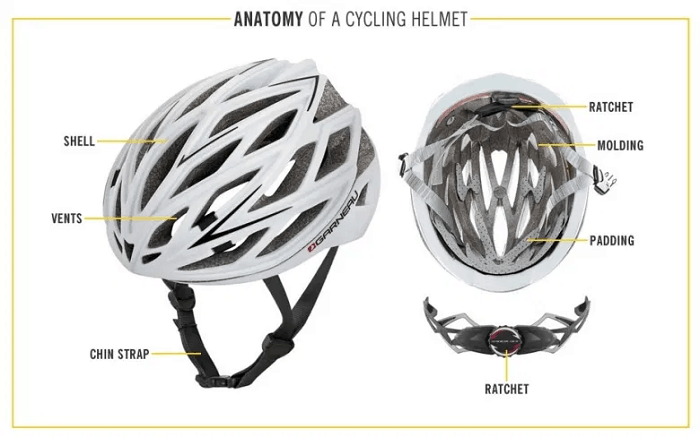
Bicycle helmets come with liners, shells, and straps. The helmet liners are typically made up of Expanded Polystyrene which is referred to as EPS foam, Expanded Polyurethane which is also called PU or EPU, and Expanded Propylene otherwise known as EPP. Often the helmet shell for more affordable helmets is made up of ABS, PET, or polycarbonate plastic. Other helmet shells consist of Kevlar or fiberglass. The straps of these helmet parts are produced using either polypropylene or nylon.
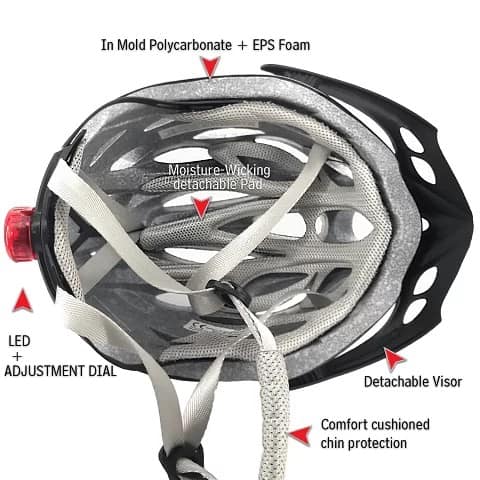
The construction of the interior part is of equal importance. Helmets that consist of ring-fit systems come with adjustable rings. Helmets that are equipped with fitting pads usually come with a hook-and-loop fastener and it is added to the helmet using glue. After that, the pads are attached. A lot of cheaper options come with pads that are directly glued onto the interior of the liner, while other helmets have a cloth or plastic liner.
Helmet manufacturing companies follow various construction patterns to build the best helmets that can provide superior protection to the rider’s head. The industry-standard construction patterns include a very hard and sturdy outer shell, a highly compressible inner liner, and last but not least pads and straps.
Firstly, let’s get down to the materials that make up a highly protective helmet.
Materials
1. ABS
ABS, which is short for Acrylonitrile Butadiene Styrene, is one of the most used materials for building hardshell helmets. This is because it is very tough, sturdy, and comes with an exceptional ability to resist impacts. Also, a fun fact about ABS is that this is the same material used to make Legos.
2. Carbon Fiber
Carbon fiber is a strong and premium material that allows the helmet to be durable and stiff. Also, even while being so strong it is very lightweight. Often, carbon fiber is used to build full-face helmets for mountain biking.
3. Kevlar or Aramid
These materials have such strong capabilities that you will be happy to know that they are also utilized in the manufacturing process for bulletproof vests. Therefore, you can understand exactly how much protection it has to offer for your bicycle helmets. It increases the strength of your helmet in specific areas so that you can get additional protection in case of an impact.
4. EPS Foam
EPS stands for Expanded Polystyrene. So what does it do? In the case of an impact, this foam gets crushed and absorbs the energy from the impact to protect your head. This is an exceptional material that gets the job done. The only drawback of EPS foam is that once it is crashed it cannot be used anymore and must be replaced immediately. This is why it is crucial that if your helmet has been involved in an accident, it should be replaced as soon as possible.
5. EPP Foam
EPP or Expanded Polypropylene foam is quite a lot like EPS foam and is used for building ski helmets. The main difference between EPP and EPS foams is that EPP can endure several impacts and it is also able to rebound after an impact. As a result, it is thicker and also costs more than a helmet consisting of EPS foam.
6. Polycarbonate
Polycarbonate is used to manufacture hard shell and in-mold bike helmets. The process of molding the polycarbonate allows for a very strong helmet to be constructed. This is because it bonds the shell directly to the helmet’s liner. Polycarbonate is both a lightweight and sturdy material.
7. Honeycomb
Honeycomb material is an alternate option to the usual materials that are used in helmet liners. It is called a honeycomb because it has the shape of one. How it has this shape is quite interesting. This material is formed by exerting pressure on it. This pressure allows it to be compressed and provide an energy-absorbing construction.
8. Nylon or Polypropylene
This material is used to produce the strap of a helmet. It is a very important component of the helmet as it allows the helmet to stay on your head at all times. Therefore it requires a reliable material to be used in its creation.
Now let’s see how these materials come together to form the three main components of any bicycle helmet.
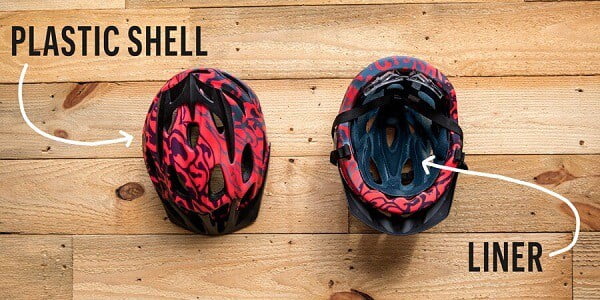
9. Helmet Shell
The type of material used to build the shell depends completely on the price of the helmet. Cheaper helmet models are commonly made with PET plastic. This material is usually used to produce plastic water bottles. The shell is usually attached to the liner using a special glue. It is then taped at the sides so that it looks smooth. With that being said, a lot of inexpensive bike helmets do not have any tape or glue on them.
Expensive helmet models have their shell in-molded. This way, the liner stretches to the shell. These helmet shells are built with high-quality plastic materials such as polycarbonate. This is because these plastic materials can endure the high temperatures that come with the molding procedure.
These are not the only materials used to build helmet shells. A lot of helmets utilize ABS plastic. Many helmets used for BMX are made of composite shells consisting of fiberglass or Kevlar fiber.
10. Helmet Liner
If we had to choose the most important part of the helmet, it would be the liner. The liner is basically the foam that soaks up all the shock or energy dissipated in the case of an impact. As we mentioned above, the liner for bike helmets is made up of EPS foam.
Affordable bike helmets are built following standard procedures. First, grains of EPS are put in molds. Then steam is used to apply pressure there to expand it. On the other hand, high-end and premium helmets utilize nylon, metal mesh, and polypropene to strengthen the helmet’s internal construction. You will not be able to tell this by seeing the helmet, but the reinforcement there and is crucial for your safety. This is especially the case, for helmets that have big air vents.
EPS foam is available in various densities. This is to better manage impacts during an accident. There are soft layers that are made to encounter light impacts and much harder layers that are required to withstand more severe impacts. As the bicycle industry is always trying to find new ways to improve, more materials are being used now to make liners. These include the aforementioned EPU and EPP. These materials follow different construction techniques.
11. Straps

The most used materials for producing straps are nylon and polypropylene. They both seem identical if you take a quick look at them. However, they differ in terms of texture, fabric quality, finishing, and many other elements.
Bike helmets that have shells glued onto them consist of straps attached to the liner. If the helmet goes through the molding process, the straps are attached to the helmet after the molding procedure and are connected using an anchor. On the other hand, hard shell bike helmets come with straps that are connected to the shell using rivets.
The buckle is another vital part that makes sure the straps stay in place and the helmet does not come off your head. These buckles are manufactured with materials such as plastic or nylon. You might also come by helmets with metal buckles.
12. Advanced Protection
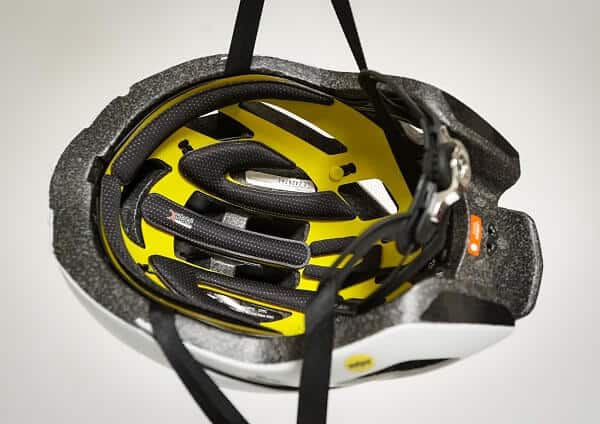
Multi-Directional Impact Protection System, otherwise known as MIPS, is basically a safety technology. When applied to a bike helmet, it helps to lessen the effects of rotational forces on the brain during an impact.
There are two types of impacts that can occur during an accident. It can be either a direct impact or an oblique impact. Therefore, forces from these impacts can either be linear or rotational. The EPS foam used in the helmet’s liner is used to protect from direct impacts. The EPS foam takes on the linear force instead of the rider. Unlike direct impacts, oblique impacts strike at an angle. When an oblique impact hits the helmet, the helmet slides along the head. That is where MIPS technology comes in. It provides an extra layer between the rider’s head and the foam. Therefore, when the
Impact occurs, the helmet rotates the head by grabbing it. As a result, the MIPS part absorbs the energy from the impact instead of the head.
Another technology used to protect your head from impacts is WaveCel. This feature is basically a honeycombed liner material that is built to crumple in the case of an impact to absorb both linear and rotational forces from the impact.
Type of Bike Helmets
There are many different types of bicycle helmets. Each helmet is designed with the rider and their various riding styles in mind. All these helmets can be categorized into 4 different types of bicycle helmets. They are:
1. Road bikes
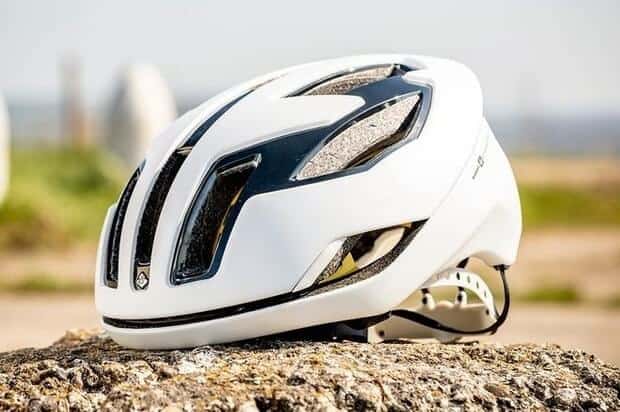
Helmets for road biking come with a variety of features. First of all, they look amazing. These helmets are available in different decal designs and colors for you to choose from. They come with visors that can be clipped on and off to keep the sunlight off your eyes while you ride. Also, it can be quite difficult to wear sunglasses while riding a bike, that is why the helmet consists of an integrated optical shield. For time trial riders, the helmets feature a long tail to reduce air resistance. Last but not least, a lot of road bike helmets feature a net that prevents bugs from entering the helmet through the air vents.
2. Mountain bikes

Mountain bike helmets also have a great appearance. They are available in various colors and a lot of them come with tremendous decal designs. These helmets have fixed extended visors for your protection. Also, a lot of modern mountain bike helmets have a place where you can attach a Go-Pro. This is because a lot of riders like to catch their mountain biking adventures on camera.
3. Commuter bikes
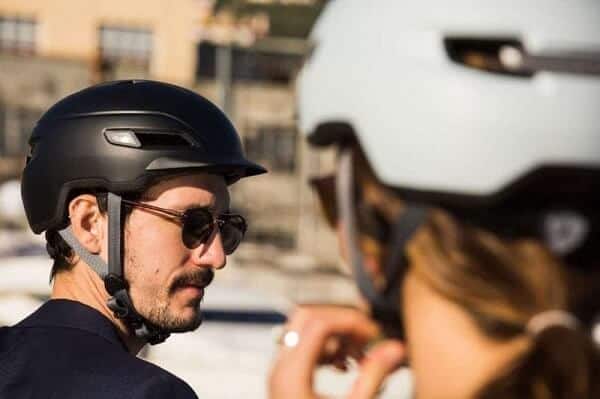
Just like the aforementioned helmets, commuter bike helmets will come in a lot of colors & decal designs to match your preferences. They are equipped with integrated lighting to remain visible on the busy city streets especially at night. A lot of the new and advanced commuter helmets come with heart rate monitors so that you can keep track of your health. They also feature a Bluetooth connection so that you can listen to your favorite music or answer calls through your phone.
4. Aero

These helmets are made for road racers or riders who like to ride super fast. Therefore, these are built to reduce air resistance and come with a long tail so that you can reach maximum speed. It also has fewer vents and a shield that keeps your face safe and can be used instead of sunglasses.
Frequently Asked Questions
Q1. How do helmets having MIPS operate?
Ans.: A bike helmet that has MIPS technology features a layer that lies in the middle between the EPS foam and your head. If your head is met with an oblique impact, the helmet holds on to your head and makes it turn along with the helmet. This way the MIPS layer takes on all the rotational forces from the impact and keeps your head safe.
Q2. Will I be able to add MIPS to my existing helmets?
Ans.: Unfortunately, you cannot add MIPS to your existing helmet. MIPS is basically a design that is implemented onto the helmets by the manufacturers.
Q3. What are the differences between helmets having MIPS & WaveCel protection systems?
Ans.: The key difference between the two is that MIPS is primarily used to protect against rotational forces. However, WaveCel protection systems can provide safety for both linear and rotational forces. They both provide comparable protection results and so it is safe to choose either of the two. You can watch the video linked below to know more about this:
Q4. How much force does it take to break a bike helmet?
Ans.: According to the research paper linked below, initial cracking of the helmet can be seen within a range of 100 to 200 lbf. However, the average force is about 140 lbf. You can go through the paper yourself if you would like to know more about this research.
Q5. Do bike helmets expire?
Ans.: According to the Consumer Product Safety Commission (CPSC), you should consider replacing your helmet after every 5 – 10 years. However, the Snell Memorial Foundation expressed that a helmet is safe to use for only 5 years.
Conclusion
Helmets are very important for your safety. Therefore, we hope you learned a lot from our article and now you can choose the best helmet for yourself. Please do ensure that you buy a good helmet and not just one that will get you to buy. You cannot put a price on safety. So good luck with your cycling endeavors. Have fun and ride safely!

Hello Dion, this is a wonderful piece of information content, accomodated in on place. Much thanks for this !
I am exploring option for bike helmet designing, and for same would like to know if there is any reference design for “Ratchet” system that I can use (provided the designer permits for it), and if required can modify it.
Regards,
Varun Jaiswal